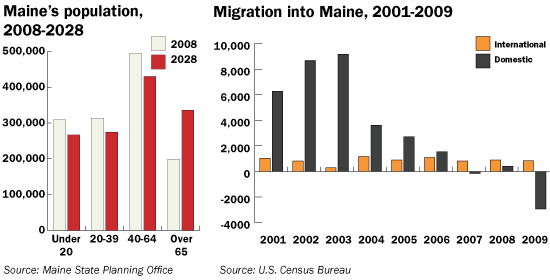Positioning for success | Despite the variables, Maine's key industries can prosper with three types of investments
The economic and demographic challenges Maine faces today are serious: a rapidly aging population and work force; the slowest population growth in the nation; below average educational attainment, particularly relative to our New England neighbors; and a widening gap between urban and rural rates of growth and levels of prosperity. On top of these local challenges, Maine also faces the national and even international forces of slow recovery from the recession caused by collapse of the housing bubble and subsequent shortage of capital for small business.
In this changing and challenging economic climate, then, what are the ingredients for business success in Maine? Over the past few months, we’ve asked this question of business and industry leaders in four important Maine industries: paper manufacturing, tourism, health care and energy. Despite their different sectors, different stages of development and different regional locations, the business leaders we spoke with highlighted three important paths to success: 1) engage in a constant process of product and technological innovation; 2) invest in people; and 3) forge creative public/private partnerships.
1. Develop new products and technologies
There was consensus among the industry leaders we spoke to that complacency is death for business. Developing new products and finding new ways to add value to old products is the only way for a business to thrive. This “creative imperative” transcends industries and geographies. Of course, the need to innovate has always been important to the Maine economy, but the recession and the nature of the economic and demographic challenges businesses face today has raised the importance of innovation. The speed of change is so much greater today that failure to innovate means not slow growth that complacent businesses live with but sudden failure. The “old way” — behemoth, monolithic paper companies; oil-fired heating systems; a reactive health care system and payment model; “cookie cutter” tourist establishments that rely on purely external attractions — is dying a hard death in Maine. The businesses that will take the lead in the emerging economy will be the ones that can break new ground and expand and diversify their markets.
No one does this better than Sappi paper in Westbrook. Sappi has created new money from old by using a 100-year-old paper machine to create patterns for high-fashion leather handbags, car dashboards and Nike soccer cleats. For the paper industry, using new technologies to reduce costs is also important. Consider Lincoln Paper and Tissue, which recently invested $10 million to modernize its steam and power cycle to reduce electricity costs, doubling the amount of electricity it’s able to cogenerate.
The renewable energy sector also depends on new technologies and products, but for different reasons.
Clearly, wind, solar and tidal each face technological hurdles to be cost competitive with electricity generation from fossil fuels. In order for the renewable energy sector to reach its full economic potential, new products and technologies must also be developed to translate renewable electricity generation into lower home heating and transportation costs for consumers. Innovative ideas like smart meters, smarter electric grids with solar back-up generators, and off-peak pricing models are essential to realizing the full promise of renewable energy. It is important to recognize that innovation is less a single “Eureka!” moment followed by a flood of new orders than the long, tedious and continual process of trial and error necessary to find the right combinations of capital, labor and organizational skill that can be commercially successful.
While innovation in health care procedures has been a hallmark of the health care industry for generations, breaking the trend of rapidly escalating costs is proving more difficult but just as important. To capitalize on the competing trends of rising demand for health care services and intense pressure to reduce costs, companies like Health Dialog in Portland are using cutting-edge analysis and data mining to add value to claims data by identifying and reaching out to high-risk patients. Athenahealth in Belfast provides software solutions to health care providers to reduce administrative costs, and not just from their own research but also from the collective experience of their thousands of clients. New products like information exchanges, where patient data are shared efficiently among providers and across geographies, and tele-health, which allows for remote diagnosis and treatment, are being developed to help insurance companies and hospitals find new ways to lower costs while improving services.
For the tourism industry, experiential and destination tourism are the future. Think of Harvest on the Harbor, held in Portland in October: a new festival to take advantage of Portland’s foodie reputation and give visitors a reason to come to Maine after the fall foliage season. Successful tourism operators will be the ones who integrate their offerings with regional amenities, provide an exceptional one-stop experience for visitors and find new ways to reach customers through technology and social media. While different from the engineering research found in energy companies, this customer relations research and development is just as important to the overall demands of being an innovative business.
2. Invest in people and training
Business leaders are worried about the widening gap between the skills that Maine workers have and the skills that Maine businesses need. It’s simple — if business owners can’t find the skilled workers they need in Maine, they’ll locate or expand elsewhere. For the paper industry, the impending skills gap is being driven by the difficulty of attracting new blood to the industry. Too few young people are considering careers in the paper industry, says Bill Cohen, spokesman for Verso Paper, because of the misguided perception that the industry is dying and that working conditions are uniformly unpleasant. Verso is taking a proactive approach, hiring 200 people to start training as replacements for retiring workers, and working with Kennebec Valley Community College to develop a pulp and paper certification program that teaches the technology skills today’s paper makers need.
In the health care industry, it’s technological skills and experience that are making qualified workers hard to find. We’re told that, increasingly, companies need workers with a unique mix of clinical knowledge, computer savvy and customer service skills. That’s tough to find anywhere, and Maine is no exception. Right now, Health Dialog has two positions open for those with programming skills and experience working with health claims data (know anyone looking for a great job?) but so far has limited Maine leads.
So how do we better align worker skills with business needs? Education and training, of course, and more of it. Take the tourism industry. We heard from Matt Polstein, owner of New England Outdoor Center in Millinocket, that the days of “passive” tourism where visitors are content to be left to their own devices are over. To take advantage of Maine’s exceptional recreational opportunities, today’s front-line service workers need to be exceptionally well trained in customer service and the culture and history of Maine. And today’s tourism owners and managers need to be exceptionally well versed in the culture of hospitality. World-class tourist destinations need world-class tourist workers, i.e., those with well-developed skills in personal interaction and the ability to listen, think, write and speak clearly, logically and persuasively.
But educating and training Maine’s existing workers will not be enough. As the baby boomers age, the Maine State Planning Office projects that a quarter of Maine’s population will be at age 65 or older in 20 years. For businesses to replace those retiring workers, attracting new people to Maine will be key. In fact, any serious economic development strategy must have at its center a plan to attract new people to Maine. Here, Maine’s quality of place can help. Skilled workers want to locate in livable communities close to outdoor recreation and arts and culture. Think of T4G, the Canadian information technology company that recently chose Saco as its new U.S. headquarters. Company president Geoff Flood is quoted in a recent issue of Mainebiz explaining this decision: “We want to be where the smart people want to live.”
3. Forge public/private partnerships
The business and industry leaders we spoke to recognize the critical role that public/private partnerships play in the Maine economy. The rising rhetoric of anti-government sentiment is good for soundbites, but not for business. All four industries have unique relationships with Maine government that reflect the enormous effect that public policies have on the Maine economy. Take, for example, the paper industry. Business leaders tell us that state support for increasing the weight limits on highways or improving the railways are critical for the industry and can pay huge dividends for the rural communities that rely on the continued existence of their paper mills. The paper industry also depends on private infrastructure like privately owned, sustainably managed timber. Much of the wood mills need is in the hands of small woodlot owners. Managing their land for timber is expensive. Another public/private initiative, Maine Forest Service’s WoodsWise program, indirectly supports the mills by offsetting the cost of sustainable management plans for small woodlot owners, helping to keep their land productive and accessible to mills.
Access to capital, especially “patient capital,” is a vital component for all of these industries, but especially in the renewable energy sector. The Maine Technology Institute, a state-funded nonprofit corporation that provides grants and commercialization assistance to Maine businesses, helps fill this need. For example, MTI has awarded $1.3 million to Ocean Renewable Power Co., which has embarked on a pilot program to create electricity from the tides of Cobscook Bay. Business leaders also mentioned the importance of regulations affecting the permitting and siting of energy generation and distribution projects. Here, too, a public/private solution, where public, private and community costs and benefits are weighed, is at the heart of continued growth and economic prosperity.
An example of public/private collaboration in the health care industry is HealthInfoNet, a publicly funded nonprofit that collects and shares electronic medical claims data. Trish Riley, director of the Governor’s Office of Health Policy and Finance, tells us that the promise of information exchanges is less redundancy and fewer medical errors, helping to reduce costs for medical providers.
The tourism industry depends critically on the Maine brand to attract visitors. Effective, coordinated marketing and protection of that brand can only come from public/private collaboration. The Maine Office of Tourism’s “Shop, Dine, and Stay” campaign is an example. Pat Eltman, director of the Maine Office of Tourism, tells us that the campaign has brought more visitors to the website and that the industry response has been positive. More important, though, are public policies that protect and enhance Maine’s quality of place — our historic, walkable downtowns, our accessible, exceptional recreational opportunities. This is what attracts visitors to Maine, and effective public/private initiatives are the key to boosting the Maine economy.
The latest economic forecasts predict that the worst of the recession is over and a slow recovery is under way. How Maine fares in that recovery will depend on how well we follow the lessons noted by the business leaders we’ve spoken with over the past year. If we combine widespread private innovation with a new public/private commitment to support innovative businesses with focused work force development programs, and make effective and clearly understood regulation and infrastructure investment, our future looks bright. Maine, with its abundance of lifestyle amenities, could indeed lead the nation out of the recession. If, on the other hand, we continue without major changes in our internal investment strategy, the past will be prologue, and we will see an acceleration of the damaging trends of slow population and job growth.
Michael LeVert, Maine state economist, and Chuck Lawton, chief economist with Planning Decisions, a South Portland-based consulting firm, collaborated on Working Knowledge, a six-part series exploring what Maine’s biggest industries need to prosper.
PART I: Setting the stage
PART II: Paper goods
PART III: Rx for growth
PART IV: Without reservation
PART V: Energy futures












Comments